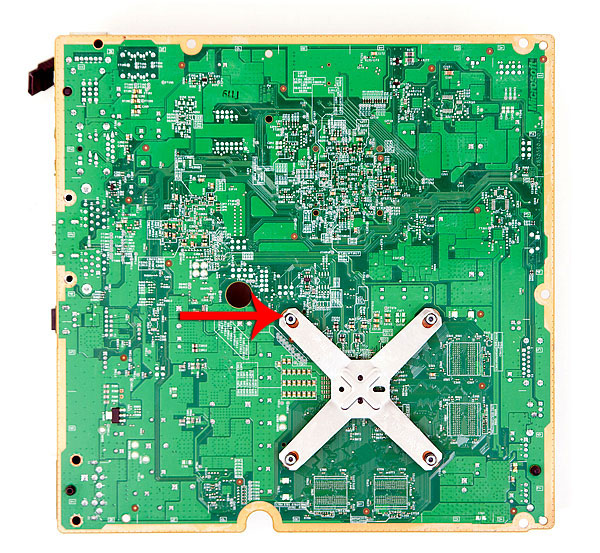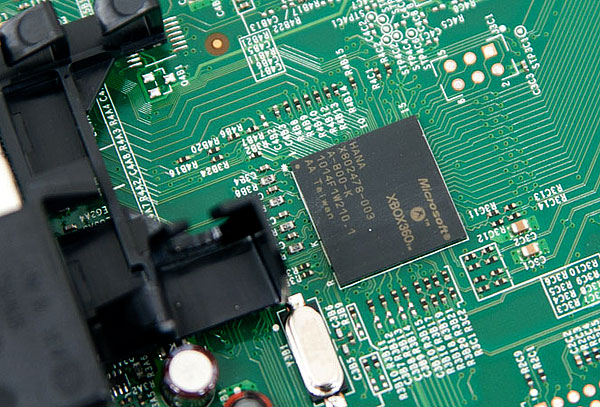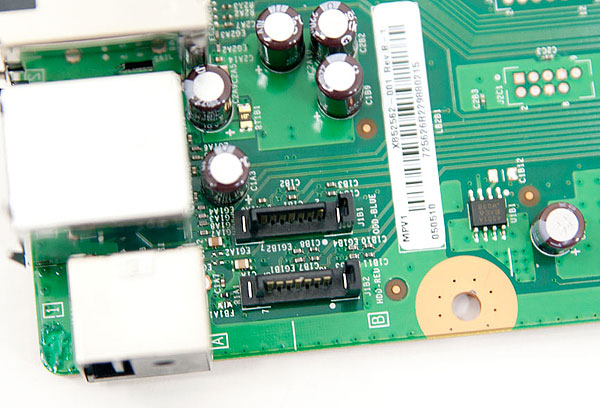Welcome to Valhalla: Inside the New 250GB Xbox 360 Slim
by Anand Lal Shimpi on June 18, 2010 1:59 AM ESTThe Motherboard
Two phillips screws hold the fan in place. You don’t need to remove them to remove the heatsink but I did anyway:

The single large heatsink is a lot heftier than what we'd seen in previous 360s, it doesn't feel quite as cheap or as insufficient. This time around it has to do double duty cooling both the CPU and the GPU.
At this point I can easily remove the motherboard and flip it over, revealing our old friend: the x-clamp.

Place your flathead screwdriver tip here, pointing away from the xclamp, and pry the clamp off at this point. Repeat for 1 - 2 more and the whole thing should come off easily.
Unlike previous Xbox 360s, the Valhalla x-clamp isn’t a pain to remove. In fact all I had to do was slide a small flathead screwdriver in each of the four slots in the clamp and push down to make the clamp pop out. I’ve marked the area on the photo above.
With the x-clamp removed the heatsink pulls off revealing Microsoft’s Xbox 360 CGPU covered with a heat spreader. The heat spreader is great for making sure no one cracks a core while working on these things.

The chip to the left of the CGPU is the 360’s South Bridge, responsible for the SATA and USB ports in the system. The chip is marked as an A0 stepping which is usually the first stepping to come back from the fab. This is probably a pretty tried and true design by now with no bugs to worry about at this point.

Xbox 360 South Bridge (top), 16MB SLC NAND (bottom)
The Hynix NAND on the motherboard is still 16MB in size. It is SLC NAND so it should last the lifetime of the Xbox as long as you don’t somehow mod it into a database server.

The third major ASIC on the motherboard is the HANA scaler/video encoder chip we’ve seen before on Jasper.
The motherboard now has two SATA ports directly on the board itself to support the new HDD tray.

I’ve also included a ton of close up shots of various parts of the motherboard in the dissection gallery for our friends at Xbox-Scene.
Have fun!
















109 Comments
View All Comments
ajp_anton - Friday, June 18, 2010 - link
Any reason not to use a slim DVD drive?jeremyshaw - Friday, June 18, 2010 - link
For your sound comparison, you listed crysis warhead!!Anand Lal Shimpi - Friday, June 18, 2010 - link
ha! that's funny. That's what I get for not paying attention to what I was copying, the load tests were done with a spinning disc in the drive (Halo 3).Take care,
Anand
MonkeyPaw - Friday, June 18, 2010 - link
Honestly, the drive noise on my Jasper isn't an issue for me, as I install my games to the HDD. It's a feature I love because it kills most of the noise, AND it boosts load times significantly. Really, putting the game data on the HDD is the only way I could fill up the drive--I don't use that space for anything else except a demo or two and the game saves.I do wish the fans were better though. I don't mind the noise; it's the pitch that gets me.
quiksilvr - Friday, July 2, 2010 - link
Doesn't that seem a bit sad, though? They couldn't even utilize a proper DVD drive so they just make users dump the game onto their HDDs?This is why they should have gone with Blu rays.. The higher density of the discs would:
1) Decrease load times
2) Decrease the spin speed of the drive, which would in turn
3) Decrease noise
And thanks to the epic coating on Bu Rays, would make the games discs a hellova lot longer without having to resort to d skins.
ck1984 - Monday, July 5, 2010 - link
Dumb comment because you didn't check FACTS and you contradicted yourself for a start the facts are blu ray is SLOWER than dvd at load times because it spins the disk slower than dvd's e.g all blu rays spin at 2x speed dvd's go up to 24x i think. This is the reason PS3 has to install parts of all games to hard drive to decrease load times. You contradicted yourself when you said 1) decrease load times then said for your 2nd point decreased spin speed also, as mentioned before decreased spin speed means decreased load times as it doesn't read the data off the disk as fast. The only advantages it has is storage space (on that point hard drives are quickly becoming the future with online downloads as the the HDD is faster and holds enormous amounts of data way faster than blu ray and holds more data) and decreased noise thats it blu ray isnt the future for gaming its way too slow a very good example of how slow it is is to time how long it takes to put a small amount of game data to hard drive on the ps3, the load times you talk about are the ps3's hard drive running partially installed parts of the game compare the install time of the ps3 which only installs parts of a game, compare that to the 360 when you dump the ENTIRE dvd to the hard drive.Xentropy - Tuesday, July 6, 2010 - link
You seem to be forgetting that increased density counters the slower spin speed in this regard. Just because a smaller arc of the disk is read in the same period of time doesn't mean more bits aren't in that smaller arc than in the larger arc of a DVD.To answer in more detail, 1X on a DVD refers to 1.32MB/s. Equivalent to a 9X CD speed. 1X Blu-Ray refers to 36MB/s. So about the same as a 27x DVD drive. Yes, despite slower rotational speed, a 1x Blu-Ray drive (and most are 2x since at least 1.5x is required to play a movie at Blu-Ray quality) reads data at a far faster rate than even a 16x DVD drive.
The reason the entire Blu-Ray isn't installed to the hard drive in the PS3's case is the sheer amount of data involved. Two games would completely fill a drive.
Xentropy - Tuesday, July 6, 2010 - link
Meh, to correct myself, my sources mixed up bytes and bits. A 2X Blu-Ray drive is about as fast as 7X DVD, at least at the outer edges of the DVD. DVD's read inside-out, though, and the Blu-Ray is actually faster than the first half or so of a 12X DVD drive's first layer of data, but slower than the last half. Functionally, the difference is small in the overall bits read per time between the two formats at 2X BR vs 12X DVD.CrimsonFury - Saturday, July 31, 2010 - link
The speeds you quoted are not in the same format. The Blu Ray speed you quoted is in megabits while the DVD speed you quoted is in megabytes (also 1x DVD speed is 1.38MB not 1.32MB)To convert from megabits to megabytes you divide by 8. So 1x BluRay = 4.5MB (Megabytes).
So a 2x BD drive like the one in the PS3 has a speed of 9MB.
A 12x DVD drive like the one in the Xbox 360 has a speed of 16.5MB, almost twice the speed of the PS3s drive.
pieterjan - Friday, June 18, 2010 - link
Excactly! Takes less space, makes less noise, leaves more space for a bigger heatsink and fan, which make even less noise.